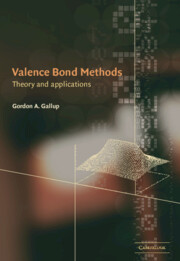Book contents
- Frontmatter
- Contents
- Preface
- List of abbreviations
- I Theory and two-electron systems
- II Examples and interpretations
- 9 Selection of structures and arrangement of bases
- 10 Four simple three-electron systems
- 11 Second row homonuclear diatomics
- 12 Second row heteronuclear diatomics
- 13 Methane, ethane and hybridization
- 14 Rings of hydrogen atoms
- 15 Aromatic compounds
- 16 Interaction of molecular fragments
- References
- Index
16 - Interaction of molecular fragments
Published online by Cambridge University Press: 13 August 2009
- Frontmatter
- Contents
- Preface
- List of abbreviations
- I Theory and two-electron systems
- II Examples and interpretations
- 9 Selection of structures and arrangement of bases
- 10 Four simple three-electron systems
- 11 Second row homonuclear diatomics
- 12 Second row heteronuclear diatomics
- 13 Methane, ethane and hybridization
- 14 Rings of hydrogen atoms
- 15 Aromatic compounds
- 16 Interaction of molecular fragments
- References
- Index
Summary
In previous chapters we have repeatedly emphasized that the principal difficulty in calculating the dissociation energy of a bond is the correct treatment of the change in electron correlation as the bond distance changes. This observation also applies to reactions where bonds are both formed and broken. In many important cases, however, the particular atom–atom distances that change significantly during a reaction are relatively few in number, and a method for accurately treating the correlation in only those “bonds” would have a clear advantage in efficiency. The MCVB method provides a method for targeting certain bonds to treat the correlation in them as well as possible. We call this procedure targeted correlation, and in this chapter we give examples using it. The SCVB method could also be used in this context.
In our previous work we have used SCF solutions of the atoms as the ingredients of the n-electron VB basis functions. With targeted correlation we go one step up and use SCF solutions of molecular fragments as the ingredients. As the name implies, this must be tailored to the specific example and must be done with a careful eye to the basic chemistry and physics of the situation at hand.
Methylene, ethylene, and cyclopropane
In this section we consider some molecules that can be viewed as consisting of methylene radicals in some combination. Earlier publications[39, 66] have covered some of the aspects of the subjects covered here.
- Type
- Chapter
- Information
- Valence Bond MethodsTheory and Applications, pp. 214 - 230Publisher: Cambridge University PressPrint publication year: 2002

